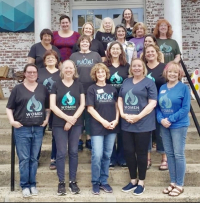The eagle lady: Mager, preparing to leave N.C., reflects on 51 years of life with raptors
 Doris Mager returned from her most recent doctor appointment with some grim marching orders. Her instructions didn’t have anything to do with blood pressure problems, cardiac health, nutritional deficiencies or an impending diagnosis. In fact, the doctor said, for 89 years old she was in amazing health.
Doris Mager returned from her most recent doctor appointment with some grim marching orders. Her instructions didn’t have anything to do with blood pressure problems, cardiac health, nutritional deficiencies or an impending diagnosis. In fact, the doctor said, for 89 years old she was in amazing health.
But something had to change.
“My doctor said, ‘Doris you really need to sleep in your house,’” Mager recounted. “I said, ‘But I don’t want to.’ She said, ‘But you really do. It just can’t be good sleeping with the birds.’”
Mager has a home in the mountains near Clyde, but she spends much of the year away from it, traveling the country with her birds of prey and living in a van. That vehicle is her happy place, a cozy spot where she and the birds can pass pleasant evenings together — they in their cages and she on her bed of memory foam, cuddled up in a blanket watching TV, sound channeled through ear buds so the noise doesn’t bother the birds.
“I love being in that van,” she said. In fact, she loves it so much that even when she’s at home, she rarely sleeps in her house. Instead, she and the birds camp out in the van.
Mager wasn’t thrilled about the doctor’s instructions, but she figured with her 90th birthday approaching it might be a good idea to try the indoor life.
Related Items
“I’m trying to be a good girl and I go, ‘Alright, I’ll go in my bed,’” Mager recounted. “So I went to bed that night and I tossed and I turned, and I tossed and I turned. Twelve o’clock midnight I said, ‘Sorry,’ walked right out to my van and fell asleep.”
Measuring years in eagles
There’s a bit more room in the van these days than there’s been at other points in Mager’s decades on the job. She travels with E.T. the great horned owl — the initials, she said, stand for “Extra Terrific,” not “Extra Terrestrial” — and Impy, an 8-year-old screech owl. But in the past, she’s traveled with an entourage including a poodle, up to three eagles and a cat. Now planning a move from North Carolina to Washington, she intends to keep traveling from her new home base.
And that’s just the traveling party. Mager’s not called “The Eagle Lady” for nothing, having kept 80 eagles over the course of her 50 years working with birds. When asked for a count including all her avian charges, from eagles to owls, the most specific number she could give was “hundreds.” The government has always required careful records for eagles but not always for other birds, and the number’s gotten so high she stopped keeping track. At one time, she had 17 birds in her care, seven of them eagles.
Some of the birds she has for a short time, while others are longer-term residents. Mager becomes misty-eyed when talking about Atsayazhi, the bald eagle from whom she now lives apart, or R.J., the beloved golden eagle that died of liver failure in 1996. Mager’s had E.T. for 34 years, and the two are close enough they have a language all their own. She knows that when E.T. smacks her tongue in a certain way, she’s asking for a sip of water, and she knows the look that means “one more mouse, please.” E.T. becomes watchful when Mager tells her there’s a kitty around and excited when she announces it’s time to go for a ride.
“People think that they’re dumb,” Mager said. “No, they aren’t dumb … I know her moods just like you know your dog’s moods.”
How it all started
Her relationship with birds has given Mager a free ticket to travel the country and even the world. She’s rehabilitated and released birds that would otherwise have died or spent a lifetime in captivity. She’s collected titles ranging from “The Eagle Lady of Florida” to “The Eagle Person of the Year.”
It’s an impressive resume, but it began humbly enough — back in 1963 when Mager, then 39 years old, was working as store manager for the Florida Audubon Society Headquarters.
“I was not a bird watcher. I didn’t know anything,” she recalled. “I knew they were pretty.”
Mager was just the woman at the front desk, the one who’d sell you a field guide or buzz you back for your appointment with the director. But that all changed when someone walked in with an injured red-tailed hawk, a bird so frightened and frightening that nobody in the building would come near it.
But Mager did. She noticed that one of its feet had a nasty infection — so bad the bird couldn’t kill the prey it needed to survive. It was hungry, it was dehydrated and it was defensive. She took it home and nursed it back to health with Epsom salt and warm water, and eventually the bird was able to fly away wild.
Today of course, “they would never let anybody do what I did,” Mager said. Regulations surrounding wildlife have expanded exponentially since 1963, so in the world of 2015 an untrained person would never be allowed to test her rehabilitation talents on an injured bird of prey. But things were different in the ‘60s, and as far as Mager and her birds are concerned, it turns out that was a good thing.
“That’s when my life changed,” she said.
From that point on, Mager took charge of all injured raptors brought to Florida Audubon, and within two years she was working with her first eagle. In 1979, Life Magazine published a full-page photo of Mager perched in an unoccupied eagle’s nest, where she stayed for a week without coming down in order to raise money for Florida Audubon to build an aviary. Two years later she left Audubon to direct the Florida Conservation Foundation’s raptor research and education program, and in 1983 she launched SOAR, Inc., an education and research group whose name stands for Save Our American Raptors. When Florida started getting too built up, she moved to the Carolina mountains and has lived here for 21 years since, though at the end of the year she’ll be moving to Washington to be closer to family. Mager still works under SOAR, continuing to use her birds to educate any group that wants to have her — she’s done presentations for groups ranging from veterinarians to elementary classes.
A never-finished job
Mager’s been a regular on the Haywood County Library’s program schedule for a long time, attracting untold numbers of kids and adults to the small presentation room in the Waynesville branch. But last week she gave her final program there.
That doesn’t mean she’s retiring, she clarified. Rather, she’s preparing to move to Washington, where she hopes to fill her schedule with a new round of regulars.
About 75 adults and kids filled the room for this last library program as Mager, E.T. and the little screech owl prepared to do their thing. It’s no easy task to keep an audience ranging from toddlers rolling on the floor to retired adults sitting in plastic chairs attentive for a full hour, but for the most part Mager managed to do just that with stories, one after the other, from 50 years of life with birds; with quiz questions and felt owl pins to reward correct answers; with a demonstration to prove that owls can’t turn their head in a complete circle, which involved one small boy walking in a circle around E.T.’s perch; and with a chance for some adult members of the audience to fly E.T.
To Mager, who came prepared with a T-shirt featuring a wide-eyed owl and sneakers to accommodate her active style of presenting, all that comes naturally.
“If you heard me the next time, I don’t know what I would tell you because I don’t practice,” she said. “I get up and start talking, period.”
With 50 years of experience, the pool of stories is vast, indeed. But Mager’s not just focused on teaching people about birds. She’s also into teaching them about life. Lessons like “don’t litter” and “don’t lie” serve as morals for the bird-centered stories that weave her presentations together.
“You’ve got to get to the kids first,” she said. “The adults loved the program, but I didn’t educate them.”
Mager loves her birds, but she knows that everyone doesn’t feel the same way when it comes to birds of prey. Birds with talons are seen as cruel killers. Even though it’s illegal, people still shoot these birds, she said — her life’s work is about making sure that stops.
“They help to keep a balance of a population of rodents down that otherwise could cause a lot of disease,” she said. “They get the sick, diseased and injured ones, and that’s what lets the species raise really good, healthy ones.”
They also indicate when something’s wrong in the environment, because toxins in the prey they eat show up as maladies affecting the raptors.
And also, they’re just cool.
“I like that they know how to live,” she said. “They live on their terms.”
So does Mager. Fixing to turn 90 in October, she’s already made plans to do a program in the Great Smoky Mountains National Park on her birthday because, she said, she doesn’t want a party — she had one of those at 80. “I want to work on my birthday,” she said. She’s planning to go hang-gliding that same week and to eventually go on a boat cruise along the Columbia and Snake rivers. In December, she’s shifting coasts to move to Washington state, where her son lives.
“I think that the most important thing is to keep busy,” she said. “Plan something five years in advance and you’ll live longer. I always have plans.”
And for now, her plans still include working — “I’ll retire when I die,” she said.
The job isn’t done when it comes to protecting birds of prey and educating people about them, but she finds glimmers of hope that encourage her to soldier on. The kids who come to program after program, never missing an appearance. The ones who look at her birds with the same admiration she does. And those who want to make a difference.
“One little boy came up to me and he said, ‘You know my daddy feeds the birds so he can shoot them out of the feeder but you said that’s not right,” Mager recalls.
No, that’s absolutely not right, she assured the boy, and in fact it’s a crime worth a $500 fine.
“He said, ‘Well how am I going to get him to stop?’” she said. “He was almost in tears.”
Mager gave him some instructions for talking to his father, but figured she’d never know how the story ended. Until she got a letter in the mail. Education had prevailed.
“That,” she said, “is what makes me go on.”









